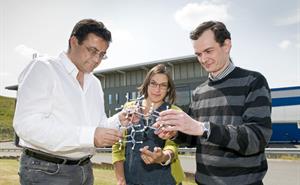In most catalytic synthesis processes the catalyst remains in the reaction medium during the whole catalytic cycle. For this reason the catalyst cannot be easily recycled and the products are usually contaminated by metal contaminants deriving from the catalyst. Moreover the organic solvents which are commonly used, are expensive, noxious to the environment and not easy recyclable because of the contamination issue.
The reason catalysis in water is rare is due to the fact that most of the known catalytically active coordination compounds are not water-soluble or decompose quickly by reaction with water. Therefore, it is essential to design new water-soluble complexes that are stable enough in water and capable of being active in catalysis. Additionally, the reactions in water are not easily studied by traditional techniques (NMR, IR, etc.) that do not provide sufficiently detailed information on how the water molecules participate in the process: enter neutrons!
Professor Antonio Romerosa and the Organometallic, coordination and photochemistry group from University of Almeria (Spain) are working on the SANDALS instrument at ISIS to study the internal reactions and mechanisms of how water interacts with a new catalyst that would work in water for organic chemistry reactions. SANDALS has a history of water studies, but has yet to be applied to this exciting new field. Only by the use of neutron techniques is it possible to have experimental information on the type and grade of interaction between the water molecule and the metal-catalyst and how the water molecules determine the reaction.

Left to right: Prof Antonio Romerosa (University of Almeriam, Spain) Dr Silvia Imberti (ISIS) and Dr Leonardo Bernasconi (STFC) with a model of the catalyst
View full-size image
“We have been studying organic chemistry in water for ages, and Ruthenium complexes in particular. There is only a handful of group in the world who can synthesise these kind of molecules. We have characterised them with NMR, UV and all sort of other techniques, but none of them could give us the definitive answer to one crucial question: how does water interact with the catalyst molecule?” stated Antonio. He now wants to use neutrons to fill in the blanks. “I was really excited when I realised that neutrons could answer exactly the precise question that had been sitting unanswered on my table for many years. Neutron scattering could change completely the way my group has been working for all these years.”
“Neutrons are very effective at showing where hydrogen, and therefore, water is. SANDALS is a total scattering instrument that has been leading the way to elucidating the structure of water and aqueous systems for the last 25 years.” says Silvia Imberti, instrument scientist on SANDALS. “Recently we have been looking at more and more complex systems, with important real life applications, such as peptides, sugars, drugs, up to real off the shelf solid catalysts. We have never yet before looked at water soluble catalysts so this experiment could open up a complete new field for us.”
In addition to the neutron experiments, during his time at Rutherford Appleton Laboratory, Antonio has started, among others, a collaboration with Leonardo Bernasconi, from the STFC Scientific Computing department. Leonardo is particularly interested in homogeneous catalysis and recently he has developed a number of codes to calculate physical properties such as the UV spectrum. The calculations match quite well with Antonio’s data and these results, together with the neutron data, can bring an unprecedented level of understanding in the field of homogeneous catalysis.
Looking into the future, Antonio described a potential application of the new catalyst in efficient, clean methods of greenhouse gas treatment. The catalyst would be used for carbon dioxide conversion in water, producing formic acid and other compounds, and so recycling the greenhouse gas. The development of the new catalyst is just one step to reinventing chemistry in an environmentally friendly way.
Professor Romerosa et al.
Research date: May 2013
Further Information
For more information, please visit the University of Almeria Organometallic, coordination and photochemistry group website
